Demystifying Video ROI: Attribution, Analytics & How to Prove Value

Let's be honest, you've probably been in that boardroom where someone asks the dreaded question: "So, what exactly are we getting from all this video content?" And if you're like most marketing leaders, you might have felt that familiar knot in your stomach because, well, proving video ROI can feel like trying to nail jelly to a wall.
Here's the thing though: video ROI isn't some mystical concept that only data scientists can understand. It's actually pretty straightforward once you know what to look for and how to connect the dots. And trust me, once you master this, you'll never again have to give vague answers about "brand awareness" when your CFO asks for hard numbers.
The ROI Formula That Actually Makes Sense
Before we dive into the fancy attribution models, let's start with the basics. Video ROI is calculated using this simple formula: ROI = (Value Generated – Cost) / Cost × 100.
Say your Toronto-based tech company spends $8,000 on a series of product demo videos and those videos directly generate $24,000 in new sales. Your ROI calculation looks like this: ($24,000 – $8,000) / $8,000 × 100 = 200%. Not too shabby, right?
But here's where most people trip up, they don't account for all the costs. You need to include everything: production expenses, team time (yes, even those three hours your marketing coordinator spent uploading and optimizing), paid promotion, and any ongoing maintenance costs. A municipal government in Mississauga learned this the hard way when they calculated a 300% ROI on their public engagement videos, only to realize they'd forgotten to include staff time for responding to increased inquiries the videos generated.

Attribution: Connecting the Dots Between Views and Value
Here's where things get interesting. Not every video conversion is a straight line from "watch video" to "buy product." In fact, most aren't.
Direct attribution is the easy one, someone watches your video, clicks your CTA, and converts immediately. These are your unicorns, and while they're beautiful, they're not the whole story.
Assisted attribution is where the real magic happens. Think about it: a potential client in Hamilton might watch your company culture video on LinkedIn, then check out your case study video two weeks later, and finally convert after seeing your testimonial video in a remarketing campaign. Each video played a role, but traditional tracking might only credit the last one.
A perfect example is a Kitchener-based manufacturing company we worked with. Their safety training videos weren't directly generating leads, but they were reducing their insurance premiums and decreasing workplace incidents. That operational value? It saved them $15,000 annually, money they could reinvest in growth.
The Metrics That Matter (And The Ones That Don't)
Let's talk about what you should actually be tracking. Sure, view counts feel good, but they're like counting how many people walked past your storefront, interesting, but not necessarily meaningful for your bottom line.
Engagement rate tells you if people actually care about your content. If viewers are dropping off after 10 seconds, that's valuable feedback about your hook (or lack thereof).
Average view duration is pure gold. When the City of Ottawa created a series of videos explaining their new waste management system, they discovered that videos under 90 seconds had 40% higher completion rates than longer versions. That insight shaped their entire communications strategy.
Click-through rates bridge the gap between engagement and action. A Burlington nonprofit found that their volunteer recruitment videos had a 12% CTR when they included a clear, compelling CTA at the 30-second mark, compared to 3% when the CTA only appeared at the end.

Proving Value: Reports That Actually Get Results
Here's the truth: your brilliant video strategy means nothing if you can't communicate its value to stakeholders. And I'm not talking about those 47-slide PowerPoint presentations that put everyone to sleep.
Start with an executive summary that hits the key points in 30 seconds or less. Something like: "Our Q3 video campaign generated 150 qualified leads at a cost of $45 per lead, compared to $78 per lead from our traditional digital advertising."
Break down results by video type and campaign. Maybe your how-to videos are crushing it for customer retention while your company culture videos are your secret weapon for recruiting top talent. A Windsor-based logistics company discovered that their behind-the-scenes videos were their highest-performing recruitment tool, reducing their time-to-hire by 25%.
Include trend analysis to show momentum. Are your videos performing better month over month? Is your cost-per-lead decreasing? These trends tell a story about optimization and growing efficiency.
The Long Game: Value That Compounds Over Time
Some video value unfolds like a good wine, it gets better with age. Customer lifetime value (CLTV) is a big one here. That onboarding video series might cost $5,000 to produce, but if it increases customer retention by even 5%, the long-term value could be massive.
Content repurposing multiplies your investment too. That 10-minute interview video becomes five social media posts, three blog articles, an email campaign, and a podcast episode. A Sudbury-based mining equipment manufacturer turned one executive interview into 18 pieces of content across six months, talk about maximizing ROI.

Attribution Models That Work in the Real World
Here's where we get a bit technical, but stick with me. First-touch attribution gives full credit to the first video someone watched in their journey. Last-touch attribution credits the final video before conversion. Multi-touch attribution spreads the love across all touchpoints.
For most Ontario businesses, a time-decay model works well, it gives more credit to recent touchpoints while still acknowledging earlier influences. A London-based financial services firm uses this approach and found that their educational video series was influencing conversions up to 90 days later.
Common Pitfalls (And How to Avoid Them)
Don't fall into the "vanity metrics" trap. Yes, a million views sounds impressive, but 10,000 views that generate 500 leads is infinitely more valuable than a million views that generate zero business.
Also, don't ignore offline conversions. If your video campaign drives foot traffic to your Markham retail location, make sure you're capturing that value. Use unique promo codes or ask customers how they heard about you.
Testing and Optimization: The Never-Ending Story
The best video marketers treat optimization like a continuous process. A/B test your video thumbnails, CTAs, video lengths, and even posting times. A Cambridge-based SaaS company increased their video engagement by 35% simply by changing their thumbnail style from corporate headshots to behind-the-scenes action shots.
Test different attribution windows too. B2B companies often need longer attribution windows (60-90 days) while e-commerce might see most conversions within 7-30 days.
Remember, ROI measurement isn't just about justifying past spend: it's about optimizing future investments. Use your data to double down on what's working and eliminate what's not.
Ready to start measuring video ROI like a pro? The truth is, every organization's measurement needs are unique, and getting the attribution models right can make or break your video strategy. If you're ready to build a video measurement framework that actually drives business decisions, let's talk. We'll help you set up tracking systems that prove value from day one.
